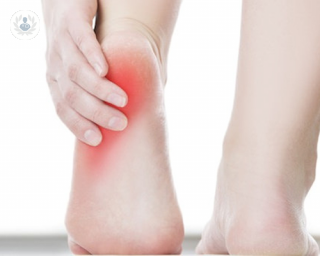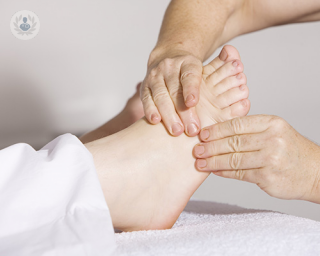Ankle tendonitis
Mr Paul Hamilton - Orthopaedic surgery
Created on: 11-13-2012
Updated on: 03-21-2017
Edited by: Conor Lynch
What is ankle tendonitis?
Tendonitis involves an inflammation of the tendon. Ankle tendonitis, then, can simply be defined as an inflammation of the tendons of the ankle. Tendons attach the muscles to the bones in your body and help you to move, as well as acting as an important shock absorber.
Tendons can be injured in a number of ways. There are a number of tendons in the ankle including the toe and ankle extenders in the front, and the Achilles tendon and flexor of the big toe in the back.

Can ankle tendonitis be cured?
Most cases of tendonitis are resolved within a few weeks providing you give the injured tendon adequate rest. It is not common to need to seek further treatment after this time.
What are the symptoms?
The main symptoms associated with ankle tendonitis are:
- pain in the affected area
- difficulty with moving the ankle joint
- swelling
- a crackling sound when moving the joint
However, if you experienced a “pop” when you injured your ankle, you may have ruptured the tendon – in which case, it’s important to see a doctor right way.
What causes it?
Ankle tendonitis is often caused by overuse of the tendon. This can occur because you play a particular sport or your job involves manual labour. In other cases, tendonitis can occur as part of the ageing process, which makes them more prone to stress.
Can it be prevented?
You can help prevent ankle tendonitis by taking appropriate measures when you exercise, such as warming up beforehand and taking regular breaks.

How is ankle tendonitis diagnosed?
Ankle tendonitis can be diagnosed with a medical examination and the doctor asking about their symptoms. However, it is likely that you will not need to see a GP, as most cases of tendonitis can be treated at home.
If you see the GP because your symptoms haven’t improved after a few months, they may recommend further examinations such as an X-ray or MRI in order to investigate whether the pain is the result of a different condition.
How is ankle tendonitis treated?
You can usually treat tendonitis at home. For the first few days after the injury, try to rest it as much as possible, apply ice, and keep the ankle elevated. Afterwards, you should be able to start moving the joint. To reduce pain and swelling, you can visit your local pharmacy for painkillers and anti-inflammatory medication.
If the symptoms don’t improve after a few weeks, your doctor might recommend physical therapy, extracorporeal shockwave therapy, or steroid injections to tackle the inflammation. In severe cases, you may be offered surgery to repair the tendon.
What part of the ankle does tendonitis primarily affect?
Tendonitis tends to primarily affect the back of the ankle, but can also affect the inner part of the ankle, as well as the outside of the ankle joint.
What are the different types of ankle tendonitis?
There are many different kinds of ankle tendonitis. The most common ones include the following:
- Achilles tendonitis (affects the back of the ankle)
- posterior tibial tendonitis (inner ankle)
- peroneal tendonitis (the outside of the ankle joint)
- flexor tendonitis (inner ankle)
What type of doctor treats ankle tendonitis?
Sports medicine physicians and specialist orthopaedic surgeons treat ankle tendonitis.












